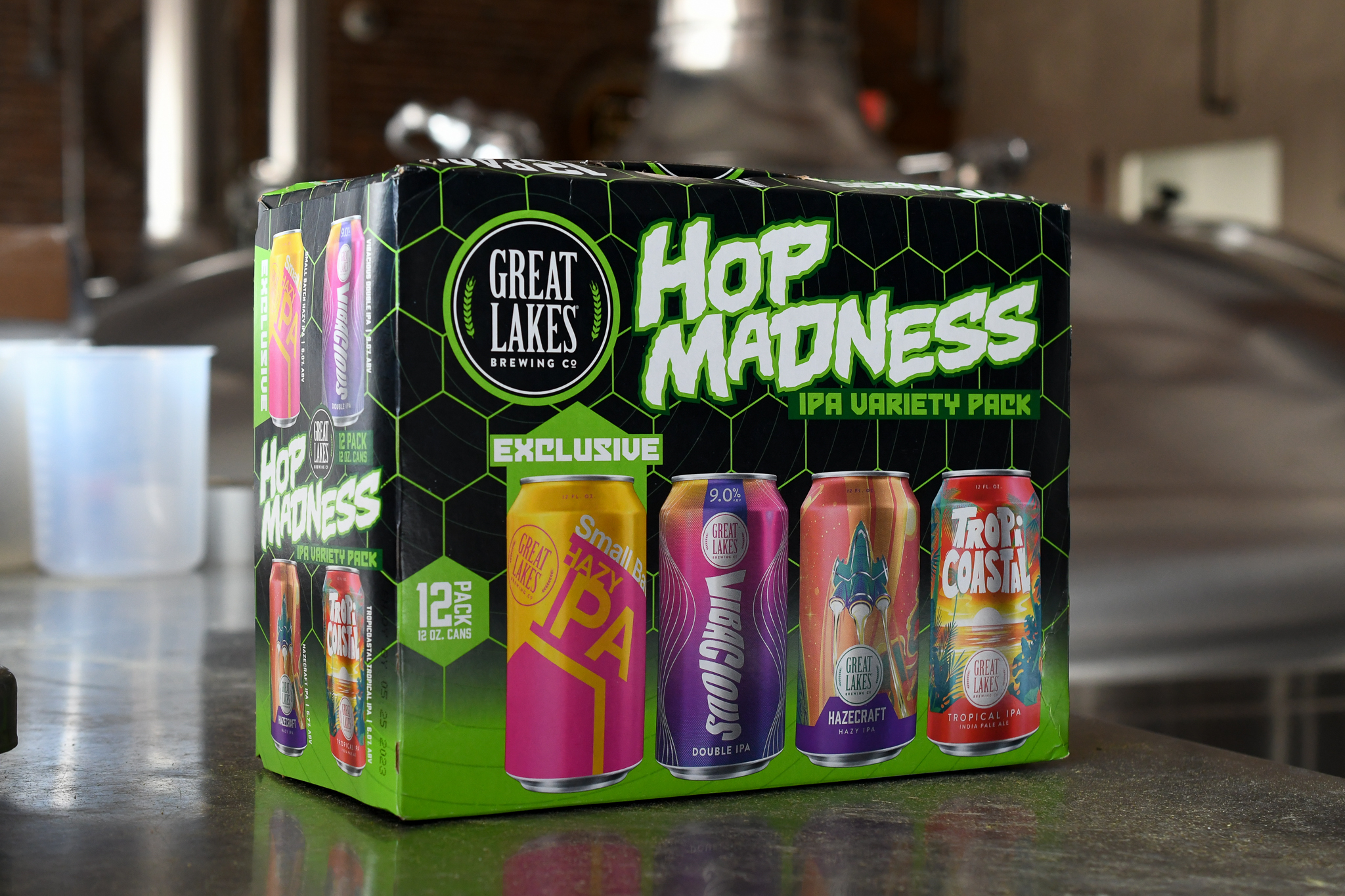
Exploring Hoppy Styles
The proliferation of everyone’s favorite hop-forward beer style has practically made “IPA” and “craft beer” synonymous in some minds. But like other beer styles, India Pale Ale is a larger ever-evolving category that holds complexities and nuances within. To talk Double IPA, Hazy IPA, Midwest IPA, and everything in between, we sat down with GLBC Brand Coordinator and Advanced Cicerone® Michael Williams.
Let’s start things off pretty easy. What makes an IPA?
An IPA is a hop-forward beer with moderate alcohol content (5.5-7.5% ABV), usually fermented by ale yeast, and generally gold-to-amber in color. What’s fascinating about contemporary IPA is that “hop forward” could mean anything from juicy, grapefruity flavor; to bursting, bright berry aroma; to bracing bitterness, and more. An IPA’s flavor profile largely depends on the hop varietal used in the brewing process. For example, English hops tend to taste earthy and woodsy, while American hops range from citrusy and piney to tropical and stone fruit. It also depends on how hops are used. Early addition hops, added towards the beginning of the boil, will produce more bitterness. Late addition (added towards the end of the boil) and “dry” hops, added during and after fermentation, will create the highly aromatic qualities that are now signature of IPA.
More and more Double IPAs, like our Vibacious Double IPA, seem to be popping up. What should people look for in this style?
As the name suggests, a Double IPA is a big, big version of a regular IPA. Hop flavor and aroma will be extremely intense, and the alcohol content for this style creeps up towards 8-9% ABV or more. Despite all the grain needed to achieve this high ABV, malt character should still be relatively restrained. Double IPAs are still deceptively drinkable beers. In the past, Double IPAs were more of a special occasion type of beer, almost always a seasonal or limited release. Today, with drinkers seeking high ABV beers more and more often, many breweries offer a Double IPA year round, and now, with Vibacious Double IPA, we do too. But we don't stop there! Craft beer fans love big IPAs so much that we also offer the Imperial IPA Series, which rotates through different exciting, unique takes on Imperial IPA throughout the year, like fan-favorite Chillwave Imperial IPA and newcomer Ruby's Revenge Imperial Grapefruit IPA. (Double and Imperial are two terms for the same style.)
When we’re talking about contemporary IPAs, Hazy IPA reigns supreme. It feels like they’re everywhere! What is it about beers like Hazecraft IPA that makes them so popular?
Lots! First and foremost, Hazy IPAs simply burst with lush, ripe tropical and stone fruit flavors and aromas thanks to the use of modern American hops. Think passion fruit, mango, cantaloupe, honeydew melon, peach – all of which you might find in Hazecraft IPA (and in our Small Batch Hazy IPA, exclusive to the Hop Madness IPA Variety Pack). We humans naturally love fruit – it’s given us sustenance and life for millennia, after all. Relatedly, we’re wired to not enjoy bitterness. This taste often indicates that a substance we’re trying to eat is potentially harmful to us. (Don’t worry, hops are fine!) Black coffee can be an acquired taste, and so can bitterness in beer. However, Hazy IPAs keep bitterness firmly in check by using wheat and oats in the malt bill. These grains balance out hop bitterness by increasing the beer’s body and mouthfeel. This makes Hazy IPAs appealing to a much wider audience than other kinds of IPAs, which tend to be higher in bitterness. Lastly, let’s be honest – that opaque appearance, when done right, is really alluring. Very Instagrammable.
I’m starting to see some IPAs out there that are described as Tropical, like our TropiCoastal Tropical IPA. If Hazy IPAs lean into tropical and stone fruit flavors so much, what makes these beers different?
Good catch! Despite the flavor similarities, there are a few aspects that make these styles distinct. One’s the body of each beer. While Hazy IPAs are fairly full bodied, Tropical IPAs drop the wheat and oats, lightening up the beer to make it crisper and increasing drinkability. If you’re sipping a few cans on the beach, you don’t want anything to weigh you down! Tropical IPAs will likely be clearer than Hazy IPAs, but we really like the way the sunset shimmers through these beers, so that’s a good thing! All the while, Tropical IPAs keep that juicy goodness that Hazy IPAs are known for. Pop open a can of TropiCoastal Tropical IPA for a side by side with Hazecraft to experience these two different approaches to tropical firsthand!
Our Great Lakes IPA takes inspiration from American IPAs. What makes it American, and which occasions do you think each beer is best suited for?
We Americans love our hops, and we love experimentation in beer. Once craft brewers in the 80’s and 90’s started brewing IPA, the style quickly moved from its traditional malt-hop balance to deep explorations in the wide, wonderful world of American hops. Malt merely provided the “canvas” upon which to paint this hoppy goodness. Great Lakes IPA hits the nail on the head for an American IPA. Its bill of modern American hops, including Simcoe, Lemondrop, Azacca, and Mosaic creates a bright, citrusy aroma that really pops. Since this beer only uses one malt, our two-row base malt, it sports a light body for an IPA. This makes Great Lakes IPA a great summertime crusher for beach days, outdoor concerts, or at the ballpark.
We often describe our Commodore Perry IPA as an English-style IPA. Can you describe what makes an English-style IPA, and how that might differ from the American style? What might it pair with?
Although IPA is the predominant beer style in the States today, it was originally a 19th century English blockbuster. At that time, IPA was certainly hop forward, but this hop character tended to be more balanced with a toasty, biscuity malt backbone, compared to the American tendency to lean decidedly towards hops. English IPA tends to have more fruity fermentation characteristics from British yeast, compared to the clean, neutral fermentation profile of American yeast. It might sound too easy, but I’d pair up an English IPA with good ol’ fish and chips. Head down to the GLBC brewpub and try our beer battered Alaskan cod with a pint of fresh Commodore Perry IPA to experience the pairing yourself!
Some of our hoppy beers use similar ingredients – Mosaic and Simcoe hops, for instance. And yet each of our hoppy beers has its own distinct aroma, flavor, and feel. Can you explain why that might be?
Something that’s cool about hops is that each varietal can hone in on a few distinct flavor profiles. Simcoe, first released in 2000, can focus more on classic American hop notes of pine, citrus, and a bit of earthiness. Mosaic, a descendant of Simcoe and released in 2012, reflects the fruit-forward aromatics desired in current brewing, showcasing blueberry, tangerine, and papaya. Hops taste and smell very distinct on their own, and once you start combining different hop varietals in a recipe, the flavor possibilities are endless. For us, Simcoe and Mosaic are almost like salt and pepper. We use one or the other in almost all of our IPAs, as those two hops seem to complement and draw out the flavor of the other hops we use so well. And while we love our standby hops, our brewers are exploring different hops in more recent releases. For instance, Vibacious Double IPA is the first beer we're brewing with Citra and Cashmere.
Finally, what should people know about IPAs? Any common misconceptions?
First, it’s important to keep in mind that hoppiness does not equal bitterness. People are getting pretty familiar what a hop-forward beer is, but there are still some who think they won’t like an IPA because it’ll be too bitter. As mentioned, Hazy and Tropical IPAs are actually quite low in bitterness, and even recent Double IPAs are keeping bitterness in check – Vibacious Double IPA is only 40 IBU. If you like citrus, floral, pine, resinous, spicy, tropical fruit, stone fruit, berry, or melon flavors, you can find an IPA you like – most likely in the Hop Madness IPA Variety Pack! Use our Beer Finder to hunt down the hoppiness near you, and get tasting.
Want the latest buzz? Subscribe to our newsletter, Much Abrew, and follow us on Facebook, Twitter, and Instagram for updates on all of our year-round, seasonal, and limited release beers. Keep up to date with brewpub releases and events at our @GLBCBrewpub Twitter and Instagram.
Questions? Email [email protected] for more information.









